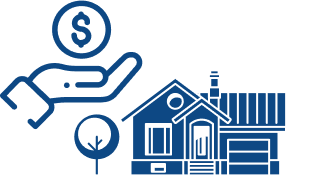What Does Being Upside-Down in Mortgage Mean? + How To Sell Underwater Property
October 2nd, 2023 / Author: Zachariah PetersonBeing upside-down in your mortgage? In today's real estate market, it's a term that may have become all too familiar. While the upside-down feeling is far from pleasant when thinking about your finances, understanding what it means and how to best navigate this situation can help put you back on track financially.
If this is your current reality and you want to grab onto a life preserver of hope, this blog post will help arm you with all the information needed to understand exactly what being upside down means for your situation, how to potentially lighten your financial load by selling an underwater property and turn a potentially daunting experience into one filled with confidence!
Sometimes, a little knowledge is all you need to stay afloat! So, stick around and prepare to splash into insights that might help save the day and get back on the right side up.
Upside Down Mortgage: What Is an Underwater Mortgage?
Being underwater or upside down on mortgage is a phrase thrown around a lot in today’s housing market, but what does it really mean? An upside-down or underwater mortgage is a situation that'll leave many gasping for air. Simply put, being upside-down in mortgage means that the value of your home has decreased while your mortgage balance remains the same. Instead of being an asset, your property has become a liability with negative equity.
In other words, upside down mortgage occurs when a homeowner owes more on their home loan than what the house is currently worth, meaning their home is worth less today than when they first purchased it. To make matters worse, selling the home would mean losing money, and the home becomes difficult to sell since potential buyers won't want to take on such a large debt.
When upside down in mortgage, you can feel like "drowning" in debt with no life preserver to be seen. Before you start panicking, there are ways out of this tricky situation we will discuss in a minute. Stay tuned.
What Does Being Upside-Down in Mortgage Mean for a Homeowner? Implications of Underwater Mortgage & Why It Happens
When you take out a mortgage, you borrow money from the lender to make monthly payments and eventually pay off the loan balance. If, at any point during this process, the value of your home decreases and your loan balance remains high, then you are considered upside down on mortgage.
It means that selling your home would mean losing money since the sale price wouldn’t cover what you owe on the loan, as the amount owed on the property is more than its estimated market value. This can happen for various reasons, most of which are associated with real estate market volatility and its fluctuations.
For example, the housing market could crash, interest rates could increase significantly, tax assessments might be higher than expected, or nearby foreclosures might affect the home’s value. In some cases, it might be due to personal factors such as taking out too much money from a home equity loan or refinancing too often without considering how long it will take to pay off the principal balance.
Either way, being upside down in mortgage can make it difficult to sell your property and get out from under the upside-down loan.
Making the Best Move: What to Do If You Have an Upside Down Mortgage?
What can you do about your upside-down mortgage? What are your options? What is your best bet? If you’ve had the bad luck of ending up upside down in mortgage, these are some of the questions probably racing through and weighing heavily on your mind. The home of your dreams can suddenly become the nightmare that refuses to go away – when you find yourself in an underwater mortgage.
When faced with an upside-down mortgage, you may feel like the deck is stacked against you. Don't despair, though; there are always options for getting out of it – you just have to know which one to take.While none of these options may sound particularly appealing, they could be just the tonic to get you and your finances right side up again.
Don't just sit there letting your situation bring you down – start researching the money-saving alternatives below.
Refinancing
First, determine if you qualify for assistance from the government; this could include refinancing and special loan modification programs.
Loan Modification
If refinancing is not an option, don't be afraid to ask your lender for help – try negotiating a payment plan or requesting that they temporarily lower the interest rate, as it can lead to easier management of monthly payments. Ask if they can offer you any sort of relief or modification program to help lower your overall payments.
Short Sale
If you find yourself backed into a corner and seeking any way out of an upside-down mortgage, a short sale could be a last resort. Despite its somewhat depressing name, it can be a freeing decision when all other alternatives have been exhausted. Instead of continuing to drown in hefty monthly payments and inevitable foreclosure action, a short sale could offer some leniency in breaking free from a seemingly endless cycle of debt.
This strategy could provide the much-needed lifeline to restore better financial footing, although it isn't without its challenges. Not all lenders will provide this option – you need to prove that you can’t afford your monthly payments and have no alternatives. Keep in mind that a short sale will significantly affect your credit history and can take a long time.
Waiting It Out
When it comes to being in an underwater mortgage, sometimes, swimming for the surface is as simple as not taking a plunge. If you want to stick it out, you can take a deep breath, put on your strong-swimming suit, and slowly bob back up to the surface. Your home's value will resurface at its own rate, giving you time to come up with other remedies in the meantime, such as making extra payments to pay down the principal faster and working to build more equity.
Sure, waiting and letting home values bounce back can take time, but you can eventually find yourself on top of that pesky upside-down mortgage scenario!
How to Sell a House that Is Underwater In Mortgage? Pro Tips
Generally speaking, selling an underwater property isn’t recommended yet some people have to sell anyway. Being upside-down in mortgage can be stressful for homeowners looking to sell their homes, making it difficult for them to attract potential buyers due to the amount of debt associated with the property. It can be a tricky situation, but fortunately, there are ways to get out from an underwater mortgage and sell an underwater property.
By refinancing your loan before listing your property, exploring government programs like HARP and HAMP, or negotiating incentives with potential buyers, you can increase your chances of successfully selling an underwater property despite being upside down on your mortgage.
Here are some useful tips on how to sell an upside-down house more easily.
Short Sale
The most common option is the short sale. In this case, the lender agrees to accept less than what is owed on the loan in order for the sale to go through. This is not always easy as lenders may not always agree to such arrangements, so it’s important to work with experienced real estate agents or attorneys who can help guide you through this process.
Another option may be asking for a deed-in-lieu which involves transferring ownership of your home back over to the lender prior to a foreclosure, instead of going through with an actual sale, so the lender would forgive the balance that remains on the home loan.
However, there are other less bleak ways to try and avoid selling short.
Exchange of Security
Not sure how to make your underwater home sale happen? Consider exchanging the security – or, in plain English, replacing the loan on your first home with the equity in a second property. By using the equity from your second property, you can make up the difference on the first property and potentially sell your troubled home at a reasonable price.
Refinancing Your Upside Down Loan
One option is to refinance your loan before listing your property so that there is less debt associated with it. This could help attract more potential buyers and make the sale easier.
Another option is to look into government programs like HARP (Home Affordable Refinance Program) or HAMP (Home Affordable Modification Program), which can provide financial assistance with refinancing your loan or modifying it so that you are able to keep up with payments.
Negotiate and Offer Incentives
Finally, you can negotiate with potential buyers by offering incentives like closing costs or home warranties – anything that could make them more likely to purchase your underwater home.
Make Your Underwater Mortgage Water Under the Bridge
We hope that you now feel more confident in your ability to successfully deal with being upside-down in mortgage. Before embarking on this journey, make sure that you understand all of the options available so that you can make an informed decision about how best to move forward with resolving your upside-down mortgage loan or selling your underwater property.
If you decide selling is the way to go, let us make things easier –request a cash offer today! If you’re thinking of getting a rehab loan to make improvements to your property in order to increase the sale value, lay it to rest – SleeveUp will pay top dollar for your house as-is, without the need to make any improvements and take care of the necessary repairs in-house.
With the right partners in your corner, your financial woes might be coming to an end sooner than expected, after all. Don’t hesitate to contact us and see what we can do for your underwater house – we are just one click away.
SELL
YOUR HOUSE
If you want to sell fast and are worried about how long the traditional process takes, and the commission and fees involved, consider working with SleeveUp Homes.





 view all blogs by this author
view all blogs by this author Cesar Gomez (83 blogs)
Cesar Gomez (83 blogs)